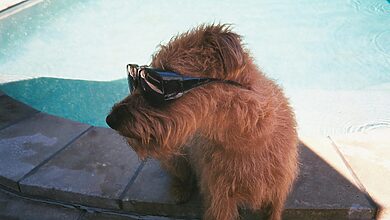Separation Anxiety Solution: Help Your Pet Cope with Alone Time

Understanding Separation Anxiety
“Don’t worry, I’ll be back soon.” As pet owners, we’ve all whispered these reassuring words to our furry companions before heading out the door. Yet, for some pets, being left alone can trigger a distressing condition known as separation anxiety. In this comprehensive guide, we’ll explore the nuances of separation anxiety in both dogs and cats and equip you with effective solutions to help your pet cope with alone time.
1. Separation Anxiety in Dogs and Cats
Separation anxiety is a common behavioral issue in both dogs and cats, but it manifests differently in each species:
Dogs: Separation anxiety in dogs is a condition where the pet experiences excessive distress when left alone. This anxiety often stems from a deep attachment to their owner and can lead to disruptive behaviors such as incessant barking, destructive chewing, house soiling, or attempts to escape.
Cats: While separation anxiety is less prevalent in cats, it’s essential to recognize the signs. In felines, it may manifest as excessive meowing, destructive scratching, urinating or defecating outside the litter box, or over-grooming. Cats with separation anxiety might become unusually clingy when their owners are present.
Understanding the specific signs in your pet is the first step towards addressing this issue effectively.
Common Symptoms of Separation Anxiety
- Excessive Whining or Barking: Your pet may vocalize their distress through constant whining or barking.
- Destructive Behavior: Pets with separation anxiety often engage in destructive activities, such as chewing furniture or scratching doors.
- House Soiling: In some cases, pets may urinate or defecate indoors, even if they are house-trained.
- Pacing or Restlessness: Restlessness and pacing are common signs of anxiety in pets.
- Escape Attempts: Dogs, in particular, may try to escape their confinement when anxious, which can lead to injuries.
- Excessive Salivation: Some pets may drool excessively when anxious.
2. Causes of Separation Anxiety
Several factors can contribute to separation anxiety in pets:
Attachment: Strong emotional bonds between pets and their owners can make them more susceptible to separation anxiety. Dogs, in particular, often form deep attachments.
Changes in Routine: Alterations in the daily routine, such as a shift in work hours or a change of residence, can trigger anxiety in pets who thrive on predictability.
Prior Trauma: Pets with a history of abandonment, neglect, or traumatic experiences are at a higher risk of developing separation anxiety.
Lack of Socialization: Insufficient socialization during the critical early weeks of life can contribute to anxiety issues later on.
New Environment: Moving to a new home or significant changes in their environment can be unsettling for pets.
Sudden Departures: The act of you leaving the house can trigger anxiety.
By recognizing these potential causes, you can better tailor your approach to managing your pet’s anxiety.
Effective Solutions for Separation Anxiety
1. Gradual Alone Time Exposure
Dogs: For dogs, gradual exposure to alone time is crucial. Start with short periods of separation and progressively extend the duration. During these sessions, use commands like “stay” or “wait” to teach patience and reinforce positive behavior.
Cats: Encourage independence in cats by providing separate play and resting areas. Begin with short departures and gradually increase the time you spend apart. This gradual approach helps cats adjust more comfortably.
2. Desensitization and Counterconditioning
Desensitization involves exposing your pet to departure cues (e.g., putting on shoes or picking up keys) without actually leaving. This helps reduce anxiety triggers associated with those cues. Counterconditioning pairs these cues with positive experiences like treats, playtime, or affection. Over time, your pet learns to associate your departures with positive outcomes, diminishing their anxiety.
3. Create a Calm Environment
Dogs: To keep dogs occupied during your absence, provide stimulating toys such as puzzle feeders or treat-dispensing toys. Consider using calming aids like pheromone diffusers, which release soothing scents that can help alleviate anxiety.
Cats: Enrich your cat’s environment with scratching posts, interactive toys, and window perches. Cats often benefit from toys that mimic hunting behaviors, like feather wands or laser pointers. These activities can keep them engaged and reduce anxiety.
4. Establish a Routine
A consistent daily routine offers predictability, which can help reduce anxiety. Stick to set feeding times, regular exercise, and consistent alone time intervals. Your pet will learn to expect these routines, making departures less unsettling.
5. Positive Associations with Departure
Create positive associations with your departures. For example, offer a special treat or a favorite toy exclusively when you’re leaving. This helps your pet associate your departures with enjoyable experiences, reducing their anxiety.
6. Medication and Professional Help
In severe cases of separation anxiety, it’s essential to consult with your veterinarian or a certified animal behaviorist. They can provide guidance on medication options or specialized training programs tailored to your pet’s needs. Medication can be a valuable tool for managing severe anxiety, but it should always be used under professional supervision.
7. Crate Training
For dogs, crate training can provide a safe space that reduces anxiety. Make sure the crate is comfortable and gradually extend the time your pet spends inside.
8. Avoid Punishment and Gradual Departures
Never punish your pet for anxiety-driven behaviors, as this can worsen the problem. Make your departures low-key and avoid emotional farewells. This can help prevent anxiety triggers.
9. Preventing Separation Anxiety
Prevention is key, especially for puppies and kittens. Here’s how to help your young pet avoid separation anxiety:
- Gradual Separation: Start by leaving your pet alone for short periods and gradually extend the time.
- Socialization: Early socialization with other pets and people helps build confidence.
- Positive Associations: Teach your pet that your departures are not permanent and are associated with positive experiences.
- Exercise and Mental Stimulation: Provide plenty of exercise and mental stimulation to prevent boredom.
Conclusion
Understanding and addressing separation anxiety in your pet demands patience, consistency, and a deep understanding of their unique needs. By gradually acclimating them to alone time, creating a positive environment, and seeking professional guidance when necessary, you can help your beloved dog or cat find comfort and confidence when you’re not by their side.
Remember, separation anxiety can be managed effectively, and with the right approach, you can make “goodbye” a little less daunting for both you and your pet. It’s all about ensuring their well-being and creating a harmonious living environment for your furry friend.







